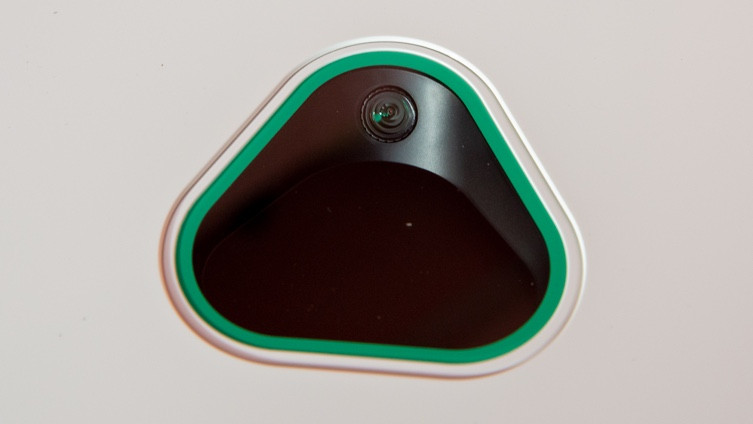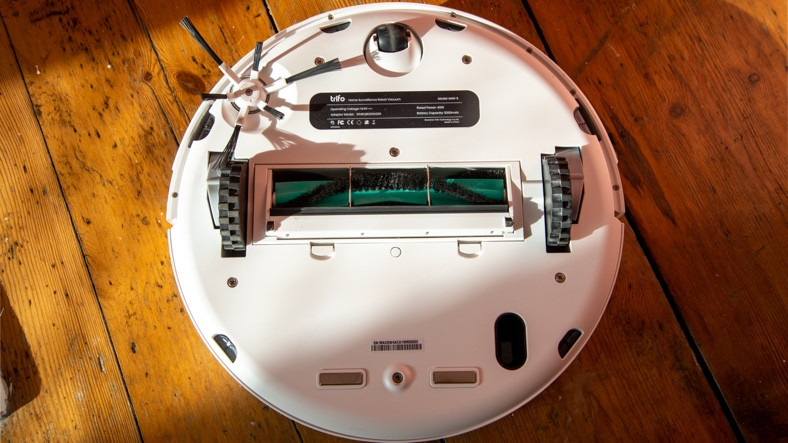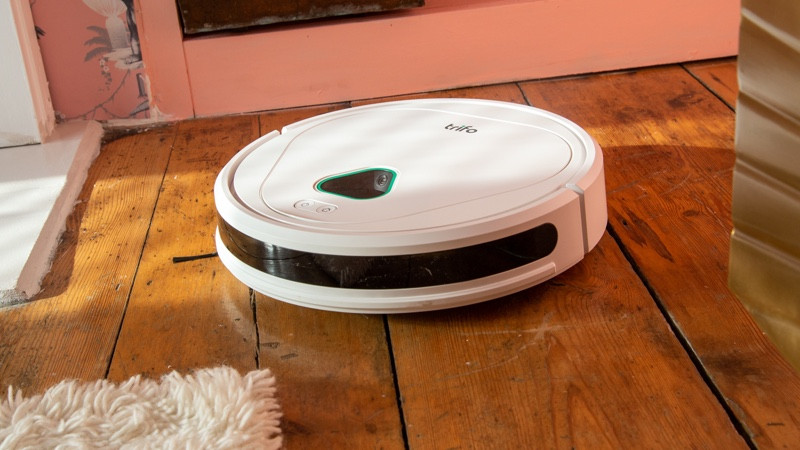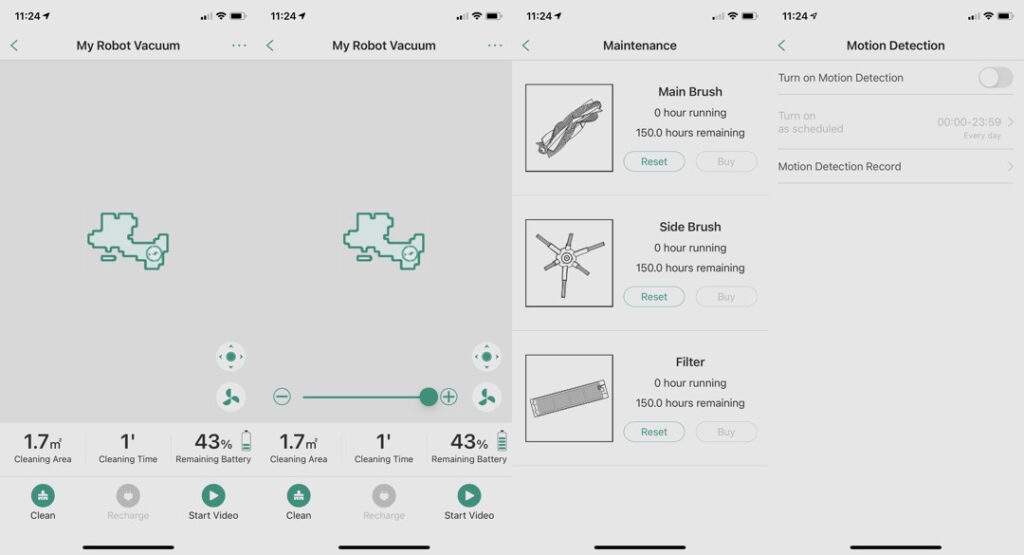Feature packed but the Trifo sucks... and we don't mean that literally
At just $399.99, the Trifo Max is a very powerful vacuum cleaner for the price. Where it can go, it does a good job sucking up dirt. It’s just a shame that the navigation was so poor when I tested it, as much of my house wasn’t touched, or the robot would get stuck. It feels as though a lot of effort has gone into putting the security camera in, but the poor results and constant notifications meant that I quickly turned off motion detection. I’d rather skip the camera and have better navigation.
Pros
- Powerful suction
- You can view the camera feed
- Large bin
Cons
- Poor navigation
- Robot gets stuck often
- Poor-quality camera
We’ve come to a point where budget robot vacuum cleaners all seem to have been churned out of the same factory, rebadged and sold on.
Standing out in this market can be hard, but the Trifo Max is perhaps the biggest attempt to be different.
I can officially say that this is the first (only?) robot vacuum cleaner cum security camera that I have ever seen. And, it’s not just that Trifo has focused on this, as the robot’s rated suction of 3000pa is just about the highest that I’ve seen, too.
With a fairly mid-level price of £369, do the features add up to a must-buy?
Well, not really, as the robot struggled to navigate my house and the camera’s poor. I’d spend the money getting a top robot vacuum cleaner, such as the excellent Roborock S4 Max.
Trifo Max: Design and build
It seems as though you can only go so far with robot vacuum cleaner design, and the Trifo Max is yet another round robot vacuum cleaner less than 3-inches high, finished off in glossy white plastic.
There’s a telltale sign that this isn’t your average robot vacuum, with a camera located at the front.
As this camera is designed for security, rather than AI navigation as with the Roborock S6 MaxV, the Max docks backwards so that it’s always looking out while on its charging dock.

Flip open the lid to reveal the 0.6-litre bin, and there’s another surprise: a USB charging port.
You can plug your phone or another device into this, although this isn’t that convenient, and you run the risk of the robot pulling your device to the floor as it moves off.

You get two physical controls on the robot: start a clean and return to dock. There’s no spot clean button but that’s not a big loss.
Flip the robot upside down and there’s a standard motorised floor brush, and a side sweeper designed to push dirt into the main suction path.

Trifo Max: Features and everyday use
There are scant few details on the sensors that the robot uses to navigate and create the map, but there’s no LiDAR on top, so the robot has to rely more on its physical impact sensors aided by the camera.
Trifo says that Max has the Trifo Intelligent Robotics Vision System (TIRVS), using “smart visual navigation”, although you need some light for this to work.
The combination didn’t perform brilliantly for me, and I found that the robot would often skip entire areas. When I first started the Max out, I got it to clean a small area in my office, but it just ran forwards, hit the door, and went back to its dock, leaving mess behind.
Giving the Max more room in my kitchen, and I had similar problems on a grander scale, and the robot often wouldn’t clean around the island or make its way around the dining table.
It did get wedged between a wall and a chair, stuck between chair legs and, worst of all, refused to dock because the underside of the robot kept hitting the grout line on the tiles.
To a degree, all robot vacuum cleaners can get stuck from time to time, but the Trifo Max got stuck a lot of the time.
It’s a shame that navigation is so bad because the Trifo Max has a 3,000Pa suction rating, which is more powerful than the Roborock S6 MaxV. When it does cover an area, that level of suction means that dirt gets easily picked up.
There’s a speaker on board with a chirpy voice telling you what the vacuum is up to. You can turn this off in the app if you prefer.

Trifo Max: App and digital assistants
You control the Max through the app, connecting it to your home network by scanning a QR code that your phone generates. It took me a few goes to get the Max connected, and I ended up having to reboot one of my mesh satellites.
Once connected, you can control the robot and start it off on a clean. As the Max moves around your home, it creates a basic map of where it’s been.
Once a map has been created, there’s nothing that you can actually do with it: you can’t set barriers or no-go zones, or split your home up into different areas.
More, the map just shows you where the robot has been, similar to how the original Dyson 360 Eye worked. As Trifo puts it, “If you want to set up no-go zones, we suggest you close the door or block off access to those areas with physical barriers.”
From the app, you can set the vacuum power using a slider. None of the steps is marked, and the slider moves too finely: is there really any point in having a slightly-below-maximum power setting?
If you use schedules, then you get a more sensible choice of cleaning powers: Quiet, Normal and Turbo.

There’s an Amazon Alexa skill, but not a Google Assistant one. You can turn your vacuum on or off, but you can’t tell it to return to the dock, and have to use the app or physical buttons.
Trifo Max: Security camera
It’s the camera that is the stand-out feature here but having used it for a few weeks, you release all of its shortcomings. As the robot sits on the floor, the camera has been angled upwards, so it captures a lot of the ceiling, and not so much of a room.
It’s not an ideal angle for capturing people either, as everyone looks as though they’re looming over the robot, with the image largely taken up with legs. Quality is poor, too, recorded at 640 x 480.
You can turn on motion detection, but with the camera’s angle and low resolution (640 x 480), you get images with a lot of leg, and people looming over the robot: it’s like watching a budget TV show about giants. Image quality is poor, beyond resolution, with chromatic aberrations around objects (a kind of purple halo) and poor colour reproduction. At night, the camera needs some light to see as there’s no IR, so don’t expect to get much detail.
You can turn on motion detection to automatically capture short animated photos of people and get a warning on the app, but this is no security camera replacement. Half the time, the image I got sent was of my back.
Motion detection is also very sensitive, often sending a flood of alerts. There’s no option to draw activity zones and no option to adjust the sensitivity.
If you want to take manual control, you can turn the camera on and drive the vacuum around your home to see what’s going on. You can check out an incident, for sure, but you still have the limitations of the Max’s poor-quality video and oddly angled camera to contend with. You can trigger manual video recording or snapshots, with the results saved to your phone’s photo gallery.

Trifo Max: Battery life and maintenance
There’s a 5,200mAh battery inside, which will last up to 120-minutes on the lowest power setting. Using the Max on its highest setting, I found that there was plenty of juice to cover my downstairs, leaving some spare to cover other areas. If the robot is running low during a clean, it will return to the dock to top up automatically.
You’ll need to clean or replace the brushes and filters, but the app has a handy count that keeps tabs on how long they’ve been in operation for, warning you when they’re coming to the end of their life.
Rated at 70dB, the Trifo Max is of a similar noise level to much of the competition: loud enough to hear, but not overly distracting.





